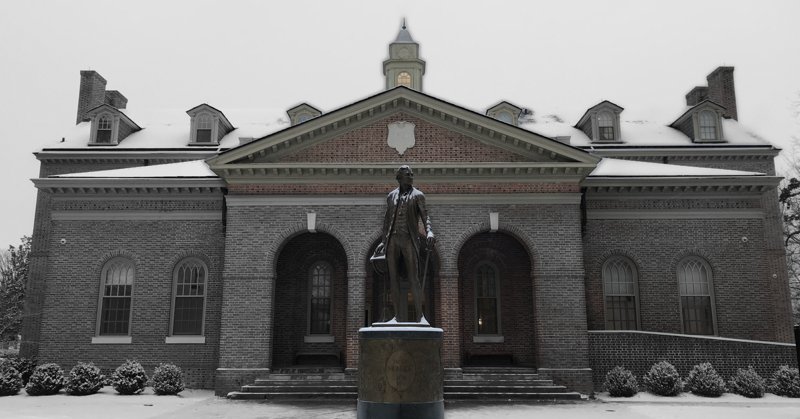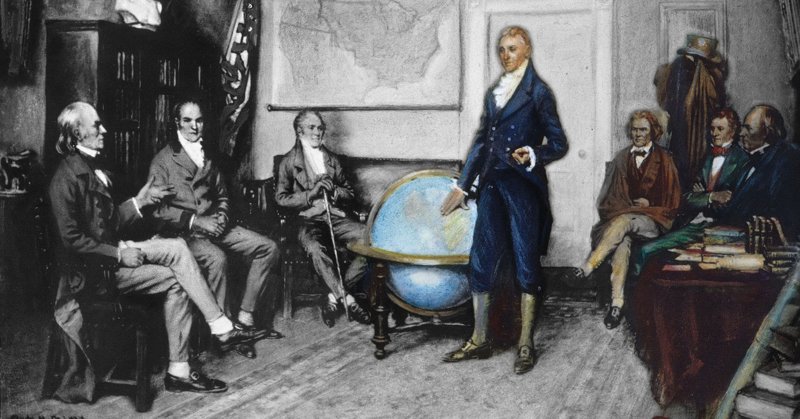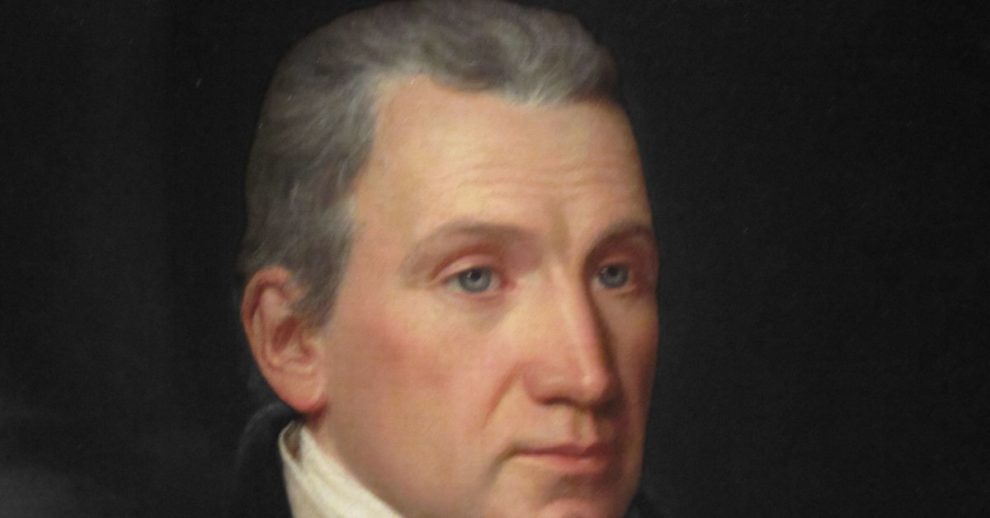James Monroe was born on April 28, 1758, in Westmoreland County, Virginia, the son of a planter family whose fortunes declined after his father’s early death. Educated at the College of William & Mary, he left school for military service, then returned to study law under Thomas Jefferson, beginning a lifelong connection to the Founders’ inner circle. In 1786, he married Elizabeth Kortright of New York, with whom he raised two daughters and maintained a steady, respected marriage until her death in 1830. Elected the nation’s fifth president in 1816, he served two full terms through 1825, presiding over the so-called “Era of Good Feelings” and the declaration of the Monroe Doctrine, which warned European powers against interference in the Americas. Known for his calm demeanor and steady patriotism rather than personal scandal, Monroe shaped U.S. expansion and foreign policy, but left office weighed down by financial troubles that followed him until his death.
Student Raid on Governor’s Palace

1. In 1775, while studying at the College of William & Mary, James Monroe joined fellow students in a daring raid on the British governor’s palace in Williamsburg, Virginia. The group broke into the armory and seized 200 muskets and 300 swords, which they handed over to the Virginia militia. That bold act of defiance marked Monroe’s first direct step into the Revolution and tied him permanently to the Patriot cause.
2. In 1820, President James Monroe ran for reelection as the nation’s fifth president. Every Electoral College delegate supported him except one from New Hampshire, who deliberately voted for John Quincy Adams. The elector wanted to preserve George Washington’s unique record as the only president unanimously chosen, leaving Monroe just one vote shy of perfection. Monroe remains the last U.S. president to run unopposed in an election.
3. In Emanuel Leutze’s 1851 painting Washington Crossing the Delaware, the figure holding the American flag behind George Washington is identified as Lieutenant James Monroe. Leutze’s catalogue and later commentary described Monroe, was then about 18 years old, taking that dramatic pose.
4. In December 1776, 18-year-old Lieutenant James Monroe crossed the Delaware River with Washington’s army to strike Hessian troops at Trenton, New Jersey. Monroe led an advance guard and was shot through the shoulder by musket fire, severing an artery. A volunteer doctor clamped the wound and saved his life, though fragments remained in his shoulder for decades. That scarred survival earned Monroe a lifelong badge of Revolutionary service.
5. In a heated White House meeting over customs-office patronage in the Northeast, Treasury Secretary William H. Crawford erupted when President James Monroe rejected his preferred appointees. Crawford brandished his cane, called Monroe a “damned infernal old scoundrel,” and whipped it in the air. Monroe responded by seizing fireplace tongs to defend himself until Navy Secretary Samuel Southard physically dragged Crawford from the room.
6. In 1791-92, Alexander Hamilton carried on an affair with Maria Reynolds and paid $1,300 in hush money to her husband, sparking what is widely considered the first major political sex scandal in U.S. history. As the scandal emerged, James Monroe-alongside Frederick Muhlenberg and Abraham Venable-investigated Hamilton’s financial ties to James Reynolds, then privately confronted Hamilton with evidence of his payments and affair. Though Monroe and his colleagues pledged secrecy, Monroe shared the letters with his close ally Thomas Jefferson, who later used the revelations to fuel rumors that damaged Hamilton’s public life.
7. In late 1814, President James Madison tasked his Secretary of State, James Monroe, with the additional role of Secretary of War after the resignation of William Eustis. Monroe technically resigned as Secretary of State on October 1, 1814, but Madison failed to appoint a successor, so Monroe continued handling both posts in practice until February 28, 1815. He remains the only U.S. official to manage two cabinet roles at once, directing diplomacy and military policy as the War of 1812 wound down.
8. On March 9, 1820, President James Monroe’s daughter Maria Hester Monroe married her cousin Samuel L. Gouverneur in the first wedding of a president’s child held at the White House. Washington society planned lavish balls in her honor, aided by Commodore Stephen Decatur and his wife, Susan. But the celebrations suddenly halted when Decatur died in a duel on March 22, 1820, forcing the cancellation of remaining festivities.
9. James Monroe preferred the title “Colonel Monroe” throughout his career, even as president, a nod to his Revolutionary War service. He had been commissioned a lieutenant in 1776 and later promoted to colonel of the Virginia militia, though he saw his most notable action earlier as a lieutenant at the Battle of Trenton, where he was severely wounded. Monroe never commanded troops in the field as a full colonel but carried the honorific after retiring from the Continental Army in 1778, using it proudly for the rest of his life.
10. In 1816, white American reformers founded the American Colonization Society (ACS) to promote sending free Black Americans and emancipated slaves to Africa. Among its prominent supporters were Thomas Jefferson, James Monroe, and James Madison, all of whom saw colonization as a potential solution to racial tensions in the U.S. Madison even became president of the Society in 1833, and Monroe actively backed efforts to acquire land in Africa for settlement.
Monrovia Named to Honor Monroe

11. In 1822, the American Colonization Society established a settlement on Providence Island off the coast of West Africa, aiming to resettle freed U.S. slaves. That settlement soon expanded to Cape Mesurado and, in 1824, was renamed Monrovia in honor of President James Monroe, who had staunchly supported the colonization project. Over the next decades, the colony matured into the Republic of Liberia, which declared its independence in 1847 and became Africa’s first modern republic.
12. During James Monroe’s presidency, a scandal erupted when 1,200 bottles of Burgundy and Champagne were charged to a White House expense account that Congress had explicitly earmarked for furniture. This came under sharp scrutiny, exposing lax oversight of executive spending.
13. In 1795, during the French Revolution’s Terror, Adrienne de Noailles (Madam Lafayette), wife of the famed general, was jailed (in Paris’s Collège du Plessis and later transferred) and threatened with execution as an aristocrat. As a U.S. minister to France, James Monroe and his wife, Elizabeth, used their diplomatic standing: Elizabeth visited Adrienne in her prison cell and loudly declared she would return the next day, implying U.S. scrutiny. France, wary of straining relations with America, abruptly rescinded the execution threat and spared Adrienne’s life.
14. John Adams and Thomas Jefferson both died on July 4, 1826, exactly fifty years after the adoption of the Declaration of Independence. Five years later, on July 4, 1831, James Monroe also passed away, making him the third U.S. president and Founding Father to die on America’s birthday.
15. After leaving office, James Monroe struggled under the weight of unpaid claims and debts from decades of public service, pressing Congress for reimbursement. In October 1830, following his wife Elizabeth’s death, Monroe relocated to New York to live with his daughter Maria and her husband, Samuel Gouverneur. He passed away at their home on July 4, 1831, without the fanfare of wealth or grandeur, and was initially buried in the Gouverneur family vault before later being moved to Richmond.














Add Comment